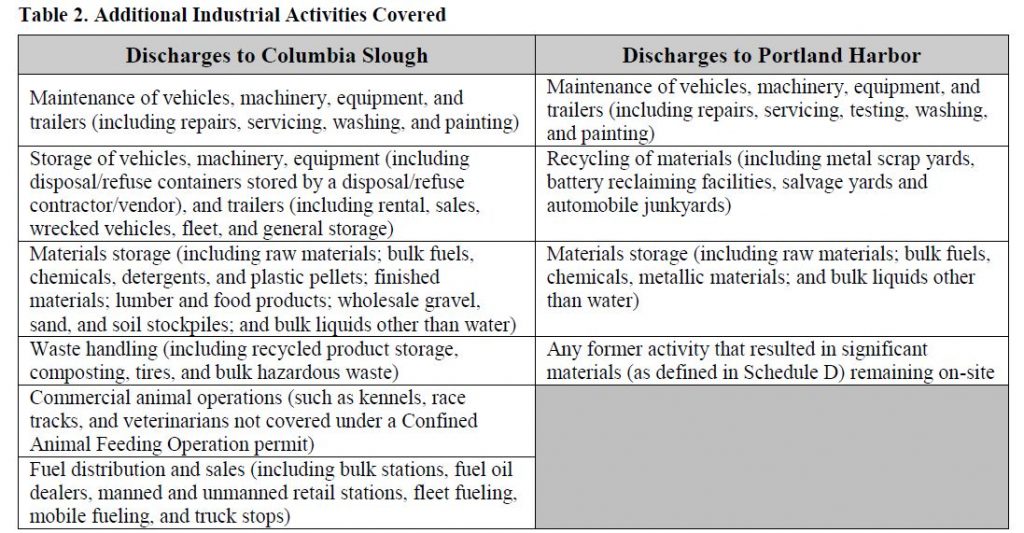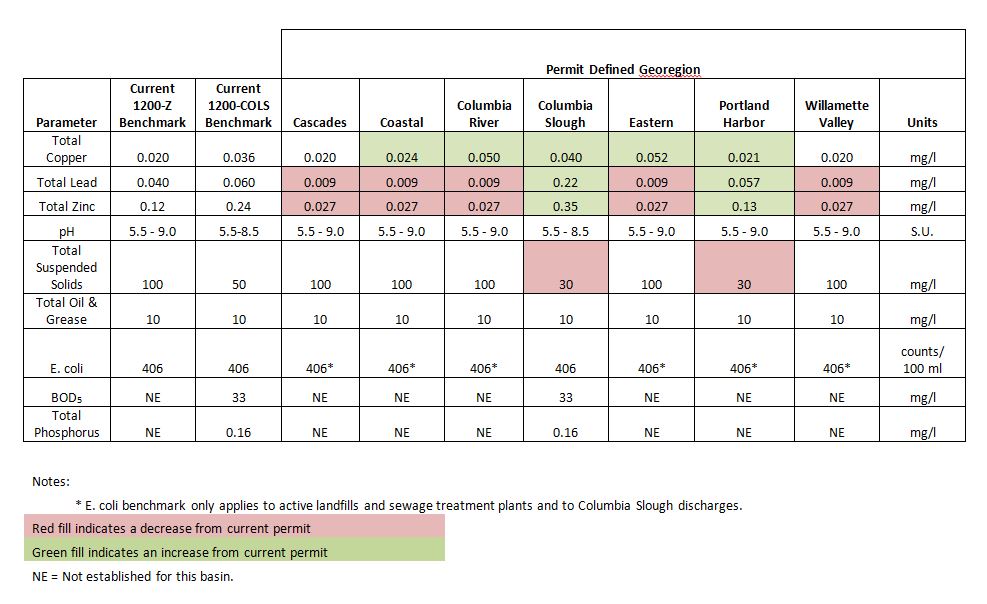If adopted, the industrial stormwater permit will expand permit coverage to more industries and trigger the need for advanced treatment to reach benchmarks.
Oregon Department of Environmental Quality (DEQ) is currently seeking public comment on the draft 1200-Z General Industrial Stormwater Permit (1200-Z), which becomes effective 1 July 2017. Comments will be accepted through 20 March 2017.
Overview
Key changes to the permit include:
- Combining the current 1200-Z and 1200-COLSB (Columbia Slough permit) permits into the new 1200-Z Permit
- Adding industrial activities requiring coverage within the Portland Harbor and Columbia Slough
- Requiring coverage when an industrial facility only discharges dispersed runoff (sheet flow) by considering the entire industrial footprint as the “point source” for runoff treatment.
- Lowering benchmarks for total suspended solids (TSS) from 100 milligrams per liter (mg/l) (current 1200-Z) or 50 mg/l (current 1200-COLSB) to 30 mg/l for facilities discharging to the Columbia Slough or the Portland Harbor
- Expanding sample collection requirements to include dispersed runoff monitoring
- Lowering benchmark for total zinc (except for permittees within the Columbia Slough and Portland Harbor) from 0.12 mg/l to 0.027 mg/l
- Lowering the benchmark for total lead (except for permittees within the Columbia Slough and Portland Harbor) from 0.04 mg/l to 0.009 mg/l
- Calculating the copper benchmark based on the biotic ligand model
- Providing for electronic submittal for Discharge Monitoring Reports and reporting requirements during the permit term
- Eliminating Tier II corrective action reports; all monitoring exceedances will trigger a Tier I report
- Including requirements for terminating coverage.
Operations that previously did not have point source discharges will now be required to have permit coverage and monitoring. DEQ now considers point source under the Clean Water Act to mean the entire industrial site, rather than an outfall pipe or ditch. Identification of all discharge points was added to the required map elements of the Stormwater Pollution Control Plan. The term discharge location has been replaced with discharge points throughout the permit. DEQ intends to capture point source discharges, as well as nonpoint source discharges, such as channeled sheet flow into a waterway or conveyance systems. This change was made to capture all potential discharges of exposed industrial stormwater, as recommended by the Environmental Protection Agency (EPA). The permit registrant must assess all potential industrial stormwater discharge points that do not infiltrate. The permit evaluation report and overview, which describes the basis and methodology used in developing the permit, provides references to methodology for sampling sheet flows.
Additionally, industries in the Portland Harbor and Columbia Slough watersheds that previously did not require coverage based on SIC codes, will be covered under the permit if they conduct maintenance, machinery and materials storage, recycling, and other activities outlined in Table 2 of the draft permit.

- Table 2 – Draft 1200Z Permit 2017
The revised permit contains significant changes to benchmarks for some watersheds, which may force more businesses covered under the Permit to install costly, advanced treatment to meet the stringent effluent limitations.
The draft 1200-Z incorporates the current Columbia Slough (1200-COLSB) permit to allow for a single, industrial stormwater permit, but also goes further to include other watershed-specific (geographic; georegion) benchmarks for the Cascades, Coastal, Columbia River, Eastern Oregon, Portland Harbor, and Willamette Valley. These benchmarks apply to all dischargers; in addition industry sector-specific benchmarks derived from EPA Effluent Limitation Guidelines may also apply. The table below compares the new proposed benchmarks to existing permits.

- Comparison of Proposed vs Existing Benchmarks
DEQ Modeling Led to Lower Lead and Zinc Benchmarks for Many Dischargers
The draft Permit Evaluation and Overview report indicates that the changes to metals benchmarks are derived from water-quality- and technology-based standards. DEQ adopted a water quality modeling approach similar to that used by the Washington State Department of Ecology for its Industrial Stormwater General Permit (ISGP) that uses risk-based Monte Carlo simulations to predict water quality impacts. The simulations are derived from probability curves for critical parameters that affect metals toxicity from each georegion, including hardness. All simulations assume a dilution factor of 5. For copper, DEQ used key parameters for the biotic ligand model for toxicity, which was recently adopted in Oregon for calculating waterbody-specific copper standards. DEQ also reviewed technology-based copper water quality data and concluded that, with treatment, the proposed benchmarks are achievable. There was insufficient lead data to develop frequency distributions of background concentrations for the different Oregon georegions. Therefore, one set of lead data was used to characterize background conditions for the entire state, with regional hardness applied in the modeling.
The Monte Carlo simulation approach is an improvement over combining only worst-case conditions that are unlikely to occur. However, such Monte Carlo simulations are overly conservative when applied to large watersheds that have a wide range of input parameters. This is demonstrated by the fact that the metals benchmarks tend to be higher when the input parameters are from smaller, specific waterbodies or river reaches such as the Columbia Slough and Portland Harbor. For the other larger, combined georegions, lead and zinc benchmarks have been lowered by roughly an order of magnitude. Based on historic stormwater data and Best Management Practice (BMP) assessment, it appears that these benchmarks will be difficult to achieve through even the most rigorous BMPs.
TSS Benchmark Concerns
The other major benchmark change is lowering total suspended solids for the Columbia Slough (currently 50 mg/l) and the Portland Harbor (currently 100 mg/l) to 30 mg/l. These reductions were made in an attempt to reduce loading of pollutants associated with particulates (e.g., PCBs, PAHs, and pesticides) to these areas, which are actively undergoing sediment remediation. This may require costly treatment that provides little to no toxics reduction.
In the Permit Evaluation and Overview, DEQ states that “…analysis of 2014-15 data submitted by 64 registrants in Portland Harbor indicate that 84 percent of the 50 reporting sites consistently achieved TSS of 30 mg/l or less. A mix of commonly applied best management practices and more sophisticated treatment systems are employed at sites achieving these results in the Portland Harbor. “ BOLD added by our team for emphasis. In short, both BMPs and treatment will likely be required for many facilities to reach the new benchmarks.
Monitoring Changes
The draft permit does provide more some relief and more flexibility in monitoring requirements. Monitoring for additional pollutants, cadmium, chromium and nickel in the current permit has been dropped. DEQ evaluated correlations among copper, lead, zinc, total suspended solids, cadmium, nickel, chromium, and mercury. Although some correlations were observed, correlations were not strong enough to reliably predict the concentration of one pollutant based on another pollutant. Therefore, the indicator pollutant concept was not further pursued. In addition, the new 1200-Z does not require that all discharges be sampled during the same storm event. This is in recognition of the fact that more infiltration devices are being constructed on industrial sites, and, consequently, there are more facilities that do not produce discharge at all their discharge points during the same storm event. Therefore, the phrase, “samples must be collected from the same storm event” has been omitted.
Next Steps
There are public hearings on the draft permit set for Wednesday, 15 March 2017 at 2:00pm at four different DEQ offices across the state. Details of the hearings can be found on their website.
KJ Consultants encourages current and potential future dischargers to carefully read the draft permit and provide comments and concerns to DEQ to help ensure that resources required for stormwater treatment are limited and targeted in application where they will truly result in protecting Oregon’s water bodies.
You may submit comments by mail, fax or email to:
Stormwater Program Coordinator
Department of Environmental Quality
Water Quality Permitting and Program Development
Headquarters, Operations Division
700 NE Multnomah Street, Suite 600
Portland, OR 97232-4100
Fax: 503-229-6037
Email: oregonindustrialstormwater@deq.state.or.us
Contact Us!
If you have questions about the draft permit or how it may affect your operations, email us team at stormwater@kennedyjenks.comor call at 503-423-4000.

If you are interested in more information on Kennedy Jenks, don’t forget to subscribe to our blog!

